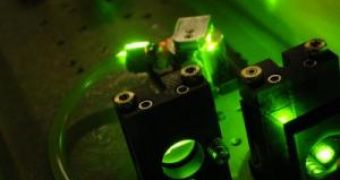Most of us regard lasers as some kind of weird devices that came from the future and are restricted only to scientific investigations, when in fact use lasers every day without even noticing. Infrared remote control? Laser powered, so is your compact disk player. Remember that the thin line of light scanning your products when shopping is not a typical beam of light, it is a laser beam! These are only low power lasers that cannot harm living tissue, while ultra-fast, ultra-intense laser beams can literally cut you in halves.
These are generally called femtosecond lasers because they pulse quadrillions of beams of light each second and are generally employed in multiple medical surgical procedures, or the most powerful of them are used for making high precision metal cuts. Professor and chairman James C. Dowell, of the Medical and Aerospace Engineering department at the University of Missouri, says that most of the usage of femtosecond lasers is directed towards the life-science and bio-medicine areas.
"The femtosecond laser has now entered the era of applications. It used to be a novelty, a fantasy," said Robert Tzou of University of Missouri. Unlike classical lasers that damage the living tissue, femtosecond lasers interact with the target in order to minimize the heat transmission into the surrounding areas to avoid damage. This enables it to make clean cuts, in the case of non-organic substances, to make strong welds or to destroy very small targets. Lasers may also be used in cancer treatment to eliminate unwanted cancer cells, thus disabling the use of dangerous chemical substances for therapy.
"Basically, the patient leaves the clinic immediately after treatment with no side effects or damage. The high precision and high efficiency of the UUL allows for immediate results." And the capabilities of the UUL do not stop here. Ultra clean channels in silicon chips and one cell at a time blood analysis, or high precision heal fast incisions can be currently conducted with the use of such technology.
Recently associated professor Yuwen Zhang and professor Jinn-Kuen Chen received a grant for laser study into creating porous solid metals out of metal powders, through a process that disables massive liquefaction. By doing so, the bonds between joint implants and bones can be improved. "With the laser, we can melt a very thin strip around titanium micro and nanoparticles and ultimately control the porosity of the bridge connecting the bone and the alloy," said Zhang.
The installation completion at MU took place in January this year and was funded by engineering alumnus Bill Thompson and his wife. Femtosecond lasers are now mostly focused on studies regarding engineering materials like metals and semiconductors, but they may also attract medical school members into collaborating in activities involving the use of femtosecond laser technology.

 14 DAY TRIAL //
14 DAY TRIAL //